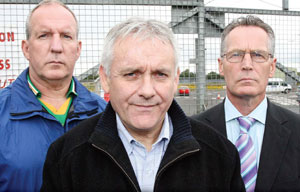25 September 2008 Edition
Busting Thatcher's dream

Bobby Storey, Brendan ‘Bik’ McFarlane and Gerry Kelly outside Long Kesh
BBC docu-drama lifts lid on H-Block escape
BY PEADAR WHELAN
THE BBC docu-drama, Breakout, screened on Monday night, 22 September, lifted the lid on the planning of the 1983 Great Escape from Long Kesh.
Billed as “the “story of the 1983 Maze Prison escape, the most audacious since Colditz”, the film-makers spoke to three of the main planners of an escape that saw 38 republican POWs carry out one of the most sophisticated and courageous IRA operations conceived in the course of the war.
Bobby Storey, Brendan ‘Bik’ McFarlane and Gerry Kelly spoke candidly about the planning and execution of the mass escape revealing, as they did so, that the operation had at its core a political message.
That message was to throw it back into Margaret Thatcher’s face that, despite her cruelty in allowing the ten H-Block Hunger Strikers to die in 1981, here we were – two years later – looking at the ability of the IRA to take control of a H-Block.
In the process they tore asunder Britain’s propaganda strategy that branded the IRA as a criminal organisation.
To understand ‘The Great Escape’ it is important that people understand the political context it which it took place.
Of course, republicans will have an insight into the raison d’etre of Irish republican prisoners of war.
They ended up in prison because of their political opposition to British rule in Ireland and while in prison they continued in that opposition.
That is why the POWs went on the Blanket and No Wash protests.
That the British Government and the unionist Prison Service tortured the prisoners to break their spirit spoke volumes about their need to inflict a major blow against the republican struggle.
LARRY MARLEY
So with the end of the Hunger Strike and the deaths of ten men, in a situation where it seemed, “that nothing was won”, the Screws gloated while the NIO under British Secretary of State Jim Prior demanded that the prisoners be put to demeaning prison work.
Needless to say, it was the foresight of the prison leadership to enlist the craft and intelligence of men like Larry Marley whose job it was to organise escapes.
The docu-drama makes it clear that Marley was thinking big. His plan was always to take as many people as possible out.
Ironically, it was the British and the Prison Service that gave these thoughts currency.
They believed their own propaganda – that Long Kesh was the most secure prison in Europe.
Well, it might have been the most secure to the gung-ho mind of our so-called ‘colonial masters’, but to the H Block POWs it was a challenge to be overcome.
While the docu-drama as a piece of television works well (especially with the interviews with Storey, McFarlane and Kelly) it was also interesting to hear from Campbell Courtney, a prison officer in the H-Blocks.
Courtney was one of the Screws who fought the escapees in the Tally Lodge, near the prison’s main gate, and imperilled the meticulous planning of the POWs, leading to the prisoners making their escape as best they could.
EUPHORIA
Of the 38 who set off in the lorry, 19 were recaptured in the immediate aftermath of the escape.
One of those was Bobby Storey.
Storey recalled how he and three others were uncovered hiding in the River Lagan and were beaten to a pulp, dragged back to the jail and left languishing naked in the prison punishment block.
Storey recalled his emotions in the punishment block.
“After about 5 or 10 minutes in the cell the feeling came over me, feelings of euphoria and relief that we had actually done it. We had busted the jail wide open. Busted Thatcher’s dream of the H-Blocks being a breaker’s yard for republicans. I was full of adrenaline and my own circumstances meant nothing.”
That spirit is the context in which The Great Escape needs to be understood: it is the defiant spirit and unconquerable spirit of republicans.


